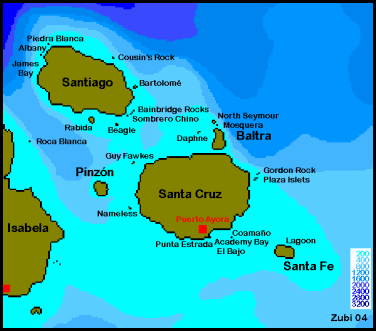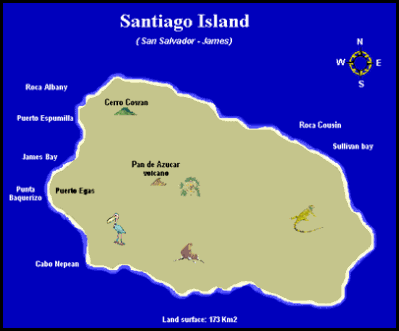Santiago Island

|
Santiago Island

 Lunch on board
as Captain Douglas motored us just a mile or so from Bartholomew to Santiago Island. Also known as San Salvador, named after the first
island discovered by Columbus in the Caribbean
Sea, or James
Island.
Chino gave us a lift ashore and we were immediately struck by the colour, or lack of it. From where we stood we could see Pinnacle Rock and Vision waiting quietly. Our guides told us the island, consists of two overlapping volcanoes, has an area of two hundred and twenty six square miles and an altitude of just under three thousand feet, atop the northwestern shield volcano. The volcano in the island's southwest erupted along a linear fissure and is much lower. The oldest lava flows on the island date back to seven hundred and fifty thousand years ago.Marine Iguanas, sea lions, fur seals, land and sea turtles, flamingos, dolphins and sharks are found here. There are apparently a large number of goats and pigs, animals that were introduced by humans to the islands and have caused great harm to the endemic species. Darwin Finches and Galápagos Hawks are usually seen as well as a colony of Fur Seals. At Sullivan Bay, a recent (1897) pahoehoe lava flow can be seen.
The view was like something from mars. Bear picked up a piece that looked like a foot and we bimbled across the hot, black surface. Puerto Egas, south of James Bay and west side of Santiago, is one of the best sites. There is a long, lava shoreline where eroded rock formations house an excellent variety of wildlife. Marine iguanas bask in the sun while land iguanas scatter around feeding on exposed algae. The tide pools contain many Sally Lightfoot crabs, which attract other types of hunters. Puerto Egas is a good spot for taking pictures.
We stopped to watch the youngsters get some fun shots.
Sullivan Bay is especially fascinating for those who are interested in geology and volcanology. The patterns are amazing.
You can walk over the uneroded, black lava flow covered with lava bubbles and tree-trunk molds in the surface.
Very Mars like.
Even the vegetation looked surreal.
There are two small beaches where turtles come for nesting. Cousin's Rock is a
well known dive site and is situated off the east coast of Santiago. It is a
triangular rock that rises about thirty feet out of the water and is made up of
many layers of volcanic rock.
ALL IN ALL SOMETHING FROM ANOTHER PLANET |